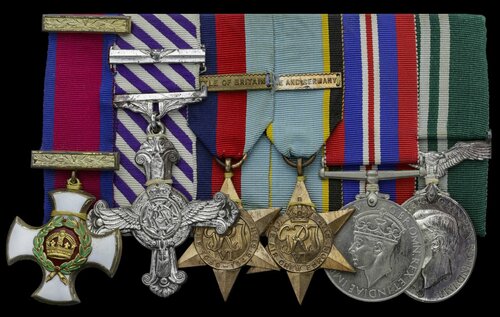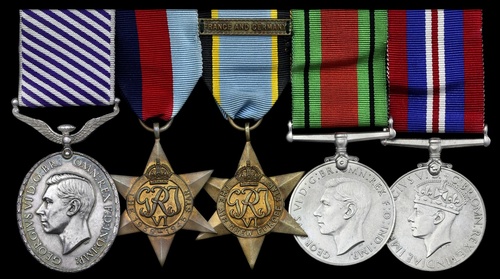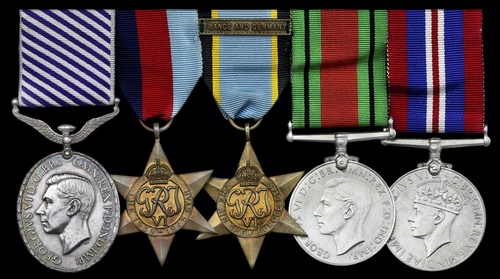An exceptional Second World War clandestine operations D.S.M. group of five awarded to Leading Seaman J. R. ‘Joe’ Houghton, Royal Naval Patrol Service, who served as Coxswain of the trawler N. 51 (MFV 2020) in a number of bold and hazardous operations to the waters off Occupied France, in order to embark or disembark a variety of “mail” and agents, the whole under the auspices of the Admiralty’s top secret “Inshore Patrol Flotilla” Distinguished Service Medal, G.VI.R. (JX.196094 J. R. Houghton. L. Smn.) official correction to prefix; 1939-45 Star; Atlantic Star, clasp, France and Germany; War Medal, nearly very fine and extremely rare (4) £4000-5000 Footnote D.S.M. London Gazette 1 December 1942: ‘For distinguished service.’ Seedie’s Roll states ‘very secret service’. A better example of Admiralty understatement would be hard to find than the bland entry in The London Gazette that heralded the announcement of the award of the D.S.M. to ‘JX. 196094 Leading Seaman Joseph Richard Houghton, and to five other naval ratings, all of whom were his partners-in-crime in several outings in the disguised trawlers N. 51 and P. 11 to waters off Occupied France in 1942, from whence they returned laden with “mail” and agents, the whole for the benefit of the Naval Intelligence Division (N.I.D. (C.)), the Secret Intelligence Service (S.I.S.), or Special Operations Executive (S.O.E.). Fortuitously, one of their operations was recorded at length by “Steven Hume”, actually onetime skipper of N. 51 (real name Stevenson Moir MacKenzie), in Blackwood’s Magazine in May 1946, appearing under the title Operation Marie Louise. But it was not until 1996 that the full story of these tough and daring trawlermen could be told in its entirety, for in that year Sir Brooks Richards, himself an ex-S.O.E. Officer who witnessed first hand some of these operations, published his official H.M.S.O. history, Secret Flotillas, a work made possible by him having been granted access to ‘closed official archives’. Fact, some say, is often stranger than fiction, and this wartime story is rich in events and characters that go a long way to proving it. Other than the usual wartime politics and intrigue that encourage the Intelligence scene’s inter-departmental rivalry, larger than life characters like Commander F. A. Slocum, R.N., Naval Intelligence’s man on the spot, Lieutenants MacKenzie and Lomenech, not to mention agent extraordinaire, “Remy”, regularly loom up on the horizon, their combined expertise keeping the lifeline to France open. Following the fall of France in 1940, and the setting up of assorted initiatives to maintain contact with the underground in France, it befell the Royal Navy, as it did two Squadrons of the Royal Air Force, to act as transport for agents, supplies and “mail”. To begin with, the former generally employed M.G.Bs or submarines to undertake these hazardous operations, but in the course of 1941 another idea was muted by Daniel Lomenech, a Free French Officer who had come to the Royal Navy via an early submarine ‘pick-up’ , and who was well versed in the habits of the Biscay fishing fleets. His idea was for a trawler to be sent from England to rendezvous with a French one, between which a quick exchange of “parcels” could take place, without having to risk our more valuable submarines, or, for that matter, M.G.Bs. And, unsurprisingly, perhaps, this proposition struck a chord with their Lordships, or certainly those who represented them within Intelligence circles. Accordingly, Lomenech was asked to go in search of a suitable vessel, and in due course he located a 60-foot Concarneau trawler in Newhaven. Then being employed as a patrol ship, with pennant No. 51, she was stripped of her guns and despatched to a Sussex boat yard to be thoroughly “re-Frenchified”. As it happened, further impetus was found in the pressing need for just such a trawler to collect “Remy”, actually Colonel Gilbert Renault, the creator and head of the Confrerie de Notre
An exceptional Second World War clandestine operations D.S.M. group of five awarded to Leading Seaman J. R. ‘Joe’ Houghton, Royal Naval Patrol Service, who served as Coxswain of the trawler N. 51 (MFV 2020) in a number of bold and hazardous operations to the waters off Occupied France, in order to embark or disembark a variety of “mail” and agents, the whole under the auspices of the Admiralty’s top secret “Inshore Patrol Flotilla” Distinguished Service Medal, G.VI.R. (JX.196094 J. R. Houghton. L. Smn.) official correction to prefix; 1939-45 Star; Atlantic Star, clasp, France and Germany; War Medal, nearly very fine and extremely rare (4) £4000-5000 Footnote D.S.M. London Gazette 1 December 1942: ‘For distinguished service.’ Seedie’s Roll states ‘very secret service’. A better example of Admiralty understatement would be hard to find than the bland entry in The London Gazette that heralded the announcement of the award of the D.S.M. to ‘JX. 196094 Leading Seaman Joseph Richard Houghton, and to five other naval ratings, all of whom were his partners-in-crime in several outings in the disguised trawlers N. 51 and P. 11 to waters off Occupied France in 1942, from whence they returned laden with “mail” and agents, the whole for the benefit of the Naval Intelligence Division (N.I.D. (C.)), the Secret Intelligence Service (S.I.S.), or Special Operations Executive (S.O.E.). Fortuitously, one of their operations was recorded at length by “Steven Hume”, actually onetime skipper of N. 51 (real name Stevenson Moir MacKenzie), in Blackwood’s Magazine in May 1946, appearing under the title Operation Marie Louise. But it was not until 1996 that the full story of these tough and daring trawlermen could be told in its entirety, for in that year Sir Brooks Richards, himself an ex-S.O.E. Officer who witnessed first hand some of these operations, published his official H.M.S.O. history, Secret Flotillas, a work made possible by him having been granted access to ‘closed official archives’. Fact, some say, is often stranger than fiction, and this wartime story is rich in events and characters that go a long way to proving it. Other than the usual wartime politics and intrigue that encourage the Intelligence scene’s inter-departmental rivalry, larger than life characters like Commander F. A. Slocum, R.N., Naval Intelligence’s man on the spot, Lieutenants MacKenzie and Lomenech, not to mention agent extraordinaire, “Remy”, regularly loom up on the horizon, their combined expertise keeping the lifeline to France open. Following the fall of France in 1940, and the setting up of assorted initiatives to maintain contact with the underground in France, it befell the Royal Navy, as it did two Squadrons of the Royal Air Force, to act as transport for agents, supplies and “mail”. To begin with, the former generally employed M.G.Bs or submarines to undertake these hazardous operations, but in the course of 1941 another idea was muted by Daniel Lomenech, a Free French Officer who had come to the Royal Navy via an early submarine ‘pick-up’ , and who was well versed in the habits of the Biscay fishing fleets. His idea was for a trawler to be sent from England to rendezvous with a French one, between which a quick exchange of “parcels” could take place, without having to risk our more valuable submarines, or, for that matter, M.G.Bs. And, unsurprisingly, perhaps, this proposition struck a chord with their Lordships, or certainly those who represented them within Intelligence circles. Accordingly, Lomenech was asked to go in search of a suitable vessel, and in due course he located a 60-foot Concarneau trawler in Newhaven. Then being employed as a patrol ship, with pennant No. 51, she was stripped of her guns and despatched to a Sussex boat yard to be thoroughly “re-Frenchified”. As it happened, further impetus was found in the pressing need for just such a trawler to collect “Remy”, actually Colonel Gilbert Renault, the creator and head of the Confrerie de Notre


/30625/Internet%20Image%201.jpg)


/114423/Internet%20Image%201.jpg)


/113430/Internet%20Image%201.jpg)

/49032/Internet%20Image%201.jpg)
/119802/Internet%20Image%201.jpg)
/108592/Internet%20Image%201.jpg)


Try LotSearch and its premium features for 7 days - without any costs!
Be notified automatically about new items in upcoming auctions.
Create an alert